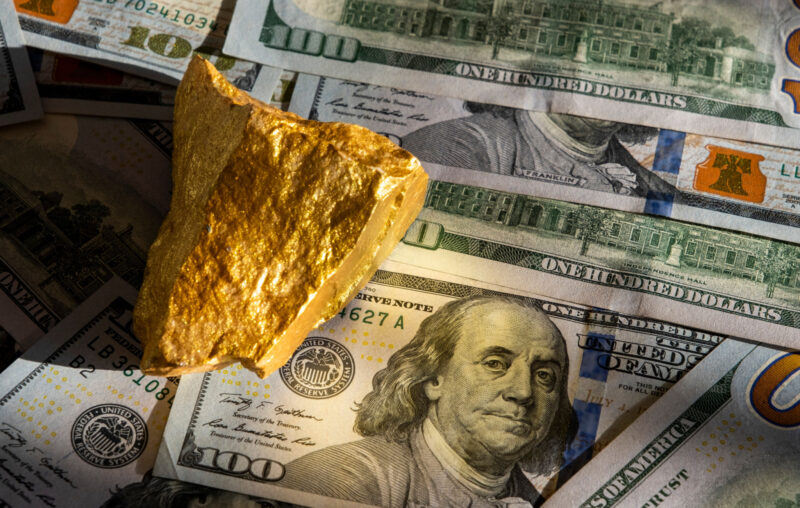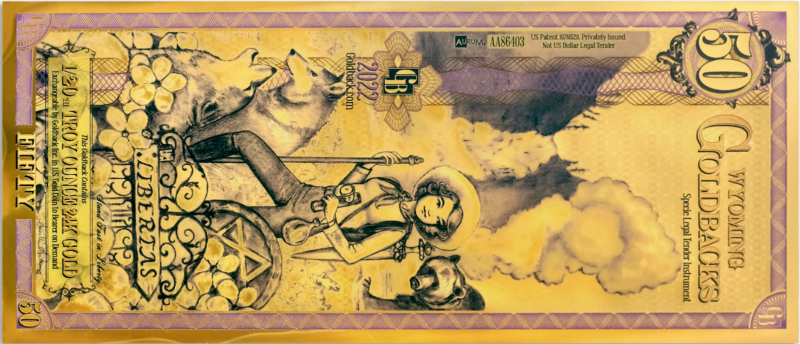What if Gold Coins Were Mated With Bank Notes? An Interview with Jeremy Cordon of Goldback

Jeremy Cordon is the Founder and President of Goldback Inc., which produces the Goldback currency in multiple denominations. The idea is simple, perhaps deceptively so. There is certainly a market for sound money that is hard to serve legally. Yet Cordon has proposed a way to serve that market – at least in an anachronistic sense. But those bought into the promise of cryptocurrencies, might have doubts. Cordon agreed to be interviewed. Here is the result.
Borders: What are Goldbacks?
Cordon: Goldbacks are basically a cash-like form of gold. A single Goldback contains one thousandth of an ounce of gold.
Borders: Short of giving away trade secrets, what kind of technology goes into producing Goldbacks?
Cordon: A lot of people think that Goldbacks are a foil product but they’re really made through a process called vacuum deposition. It’s the same technology that places a layer of gold in space helmets or in microchips in your phone.
Borders: I’m not a Bitcoin maxi, but I’m a bitcoin mostly. Yet in this distorted economic environment, Bitcoin has had issues with volatility as too many people treat it like a speculative asset instead of a digital commodity. Where do you see Goldbacks fitting into the current competitive landscape among gold, fiat, and digital currencies like Bitcoin?
Cordon: Goldback is a lot more like cash, in that it is a convenient, private, physical currency. The value is in your hand, rather than on the blockchain or on the internet. Unlike other forms of gold, though, Goldbacks are designed to be used for small transactions such as a sandwich or a gallon of gas.
Borders: It’s easy to imagine how Goldbacks might work locally, say, in the event of a financial crisis or collapse scenario. I can imagine trading Goldbacks for ammo and prepper stuff when the dollar turns to grey goo. But how do you see Goldbacks figuring into a future in which users will want rapid, global transactions?
Cordon: Goldbacks work well in any scenario where physical cash also works well. If you need to pay someone overseas then Goldbacks could do this as well, but at that point you’re working with a third-party vaulting company such as Alpine Gold. There may even be Goldback cryptos coming out over the next couple of years.
Borders: What’s interesting about subjective value in the case of Goldbacks is that the durable plastic sleeve in which the gold is encased creates a high degree of utility that makes it useful as a currency where a gold coin is not. Have you seen Goldbacks become more valuable than gold in certain contexts?
Cordon: Yes. Some people in the older generation give us pushback on premiums but what they don’t understand is that it’s more helpful to think of a Goldback as having a value as opposed to a premium. For example; when COVID-19 hit in March of 2020 Goldbacks sold out everywhere almost immediately. The only place one could buy them was on Ebay and they were $50 a piece (as opposed to the ~$2.50 price the week before).
Goldbacks have utility as money in a way that gold coins and bars don’t, which explains this price spike. I suspect that the same thing could happen again in the coming years. The people that own Goldbacks now will have a better tool than the people who have bars and coins later.
Borders: Okay, but what if, due to some circumstance – perhaps wear and tear – someone wanted or needed to extract the gold from a stack of them? Is that feasible?
Cordon: Yes! Currently we warranty every Goldback. We even allow people to turn in Goldbacks for Gold coins. Currently the top Goldback dealers offer to cash folks out at a mere 5-percent spread, which is comparable to gold coins and bars.
Borders: I’m going to ask you to be speculative, but… If you could dream big, how do you see Goldbacks operating in a global marketplace of the future?
Cordon: We can see the effects of hyperinflation in the third world. People’s entire savings can be wiped out in a week or even a day. The Central Banks in these countries are then in a pickle; their job is to make a currency that is useful and will actually be used. Right now Zimbabwe, for example, is experimenting with minting tiny gold coins. There are many other foreign central banks that are also trying to get gold to circulate. The Goldback is a much better option for these Central Banks. I think that Central Banks will use the Goldback technology because they could run out of other options. You have to remember that Central Banks are the largest owners of gold in the world. This technology could be really great for them.
Borders: The Federal Reserve and the US government don’t like competition. What properties make Goldbacks more “regulation proof” than other alternatives to “legal tender”?
Cordon: Yet there’s a decades-old multibillion-dollar precious metals in the United States anyway. It would be a stretch to call anything “regulation proof” in America anymore, but I would say that Goldbacks largely operate as a currency under state laws as opposed to federal ones. Federal law actually prohibits the creation of any currency or money, unless otherwise authorized by state law. We use a state-level law called the Uniform Commercial Code, which has been adopted by all 50 States.
Have you ever noticed a cash value on a coupon or gift card? This cash value is there because of the UCC. The way this works for Goldbacks is that they can be redeemed (in increments of 1,000) for Gold Eagles that have been minted by the US Mint. These Gold Eagles have a face value of $50. Goldbacks already have gold in them but now that gold is redeemable for gold minted by the government the same way coupons in the US are also redeemable for cash under the same law. This makes every Goldback a specie legal tender instrument because they can be redeemed for specie legal tender produced by the government.
We believe that this legal strategy is rock solid.
Borders: It seems unlikely that the adoption of Goldbacks would be sudden and institutional. Instead, it’s likely going to gain traction as a hedge against the problems of our legacy systems. Yet our legacy systems (Federal Reserve and taxing Treasury) have systems (processor networks) built upon systems (big finance). What is your vision for Goldbacks to compete in a world of titanic central banks, the WEF, the IRS, financial powers, and Visa/Mastercard?
Cordon: It’s possible that institutions could gradually experiment with Goldback tech the same way they experiment with crypto. The best likely future for Goldback would be that institutions adopt the technology in a limited way. Perhaps they replace cash with Goldbacks but leave every other digital dollar unbacked. That would still be a massive improvement. The success of the Goldback long-term really depends on how the public responds to it. If people become extremely interested and excited by inflation-proof currency, then the outlook becomes better.
Controlling the technology behind Goldbacks could become a key National interest. What if the US produced the future of cash for every country on earth? That could be an even better situation for the United States than having the waning dollar reserve status. We could end up losing that anyway. There’s a lot to think about here.
In the meantime, Goldback is too small to really be considered threatening to anyone. There’s only been about $50,000,000 worth of Goldbacks sold since 2019. That’s enormous in the local currency space, but in the dollar space, it’s too small to even take note of.
Borders: Is there anything you’re dying to explain to our readers that I didn’t cover?
Cordon: What’s been exciting for me is just how much the Goldback is expanding the precious metals space overall. The vast majority of gold bullion is owned by the Silent Generation which is quickly aging out. That generation is the most interested in coin collecting, and the younger generations aren’t aging into that interest at nearly the same rate. One estimate has the precious metals space shrinking by ~250,000 customers a year (the remaining customers buy larger volumes). This is anecdotal, but we’ve lost half of our local coin stores over the past twenty years. It bodes very poorly for the future of sound money.
We’ve seen that turn around since 2019 Goldback has added 750,000 people to the precious metals space for the very first time. Many of these people received a Goldback as a tip at a restaurant or as a gift. The majority of these customers are millennials between the ages of 24 and 42. This is adding a lot of needed fresh blood and interest into the precious metals space.
Borders: Thank you for your time, Jeremy.
Cordon: My pleasure.











